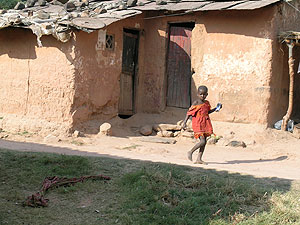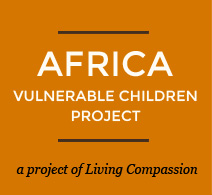This is the day we asked Theresa how we could make a difference
On Thursday, we slept in and met at 8:00 a.m. to meditate and then enjoy our group discussion outside under the trees. The monks got busy checking in on the status of our various projects, while the new arrivals toured the friary grounds and programs.
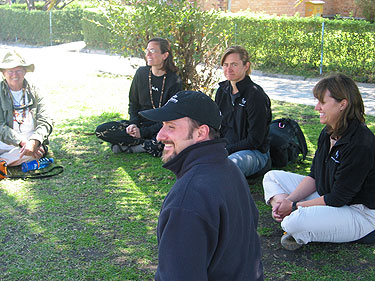
Our last group discussion held out on the Franciscan Friary courtyard lawn.
That afternoon, we went to Masala Primary School to further discussions on our involvement with them. Jen, Caverly, Alex, Dave and Ignatius met with Mrs. Mupeta and Samuel, the district building supervisor, to discuss logistics of the improvement projects. Sande, Sandy, and Sue were treated to a tour of the grounds and most of the classrooms, being greeted again and again with the children calling out in unison, “Good Af-ter-noon Vis-i-tors.” Our whole group got quite a show of traditional dancing, singing, and drumming from the Grade 7 drama class. Even the teachers came out of their classrooms to dance their hearts out.

Mrs. Mupeta once again brings teachers and staff members together to pose with us for a group photo at Masala Primary School.
When we finished up, we took a 20-minute walk from the school to the Living Compassion house to see the kids. By walking, we got a more direct feeling for the neighborhoods and local community than we would have in the car. It was great fun playing Frisbee and other games in the street (unpaved dirt road) with all the kids in the neighborhood. They taught us some local songs and games and we showed the group of at least 30 children the “Hokey Pokey.”
Once it got dark, we headed back to the friary for dinner and got a good night’s sleep.
Because we had plans for later in the day, we had to get moving early on Friday to buy more fabric for the meditation pants. This time, we went to the local open-air markets and found one booth that we practically cleaned out. While we were browsing, Brother John asked the woman there if she had prayed today. She said yes, I pray every day. Soon her prayers were answered and she looked dazed as there was no fabric left hanging on the walls. The neighboring vendors jokingly accused her of practicing witchcraft for attracting all the white people.
We returned to the friary, uncertain of the big surprise destination planned by Father Timothy for our afternoon outing. It was quite an honor to have the provincial head of all the Franciscan friars in Zambia cooking our lunch, packing the bus, and driving us off down the road. We were all impressed and touched by the open-hearted, unassuming man who it can be hard to believe was in such a position of authority. We took off down a different road and our journey was again filled with new views of Zambian village life. It was even more apparent when we turned off the main road. People along the way first stared and then smiled and waved as this strange vehicle passed. Two small boys around age 6 hopped a ride with us to their home, amazing the members of their community as they sat outside washing clothes, tending fires and babies.
When we stopped we found ourselves in a picturesque setting with a clear, calm tree-lined lake, green grass, thatched-roof lodges and safari tents called Camp Nsobe. We picnicked by the water and some of us went canoeing as well. Comfortably lounging on the grass proved to be a perfect setting for the monks to ask Father Timothy and Father Charles, another priest, about their experience of peace, providing a very enlightening afternoon.
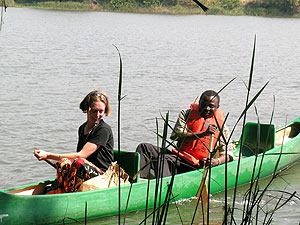
Although we were enjoying ourselves, we needed to get back to the friary to attend a special dinner (including ice cream for dessert) to honor the novice friars who were leaving for Lusaka. That evening we had our group discussion, which became a nightly event after that to help maintain our practice, even so far away from home.
On Saturday, we traveled to Kitwe —a city about an hour’s drive away—to experience some of the local crafts we had not yet seen. We purchased some handmade items to include as part of the October 22 Bridge Walk, to benefit Living Compassion’s work in Africa. It was a good excuse for the monks and retreatants who like to shop to have the opportunity and we found some things we think people at home will be really excited about.

In addition to our market excursion, we also made an impromptu stop at the SOS Children’s Village outside of Kitwe. With typical Zambian hospitality, they gave us a full tour of their extensive community on the spur of the moment. Upon entering, all we saw were numerous empty brick buildings, which we later learned were newly built classrooms. We found out that this facility was one of 450 such villages throughout the world created by an Austrian-based international organization that adopts the most vulnerable orphans in a community. As we continued further up a small hill, we began to see life in the village as kids poured out to greet us. It didn’t take long until many children were following us and asking to be “snapped” (i.e., to take their picture).
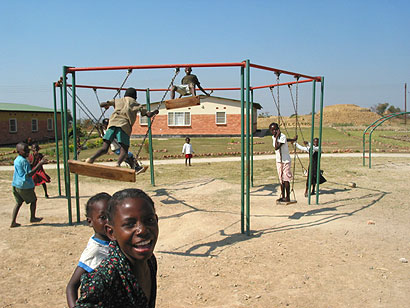
The approach of this group (SOS) is to create long-term family life for these children, much as we are doing with the Living Compassion House, but on a larger scale.
Our routine of group after dinner gave us the opportunity to process the many experiences we’d all been having.
Sunday was a big day for us in many ways. After our morning sit, we had the opportunity to attend an early mass in English at the friary. Then we headed off to Ignatius’s church, Mushili Bonano, for a second mass held in Bemba, the local language. We were treated as honored guests, with reserved seats in a church packed with close to 800 people. We all agreed that even though we didn’t understand a single word, this priest put on the best show in town and the congregation responded with raucous laughter and enthusiastic applause. Of course, the music was sensational as we now expect from a Zambian church service. At the end, we were introduced and received a warm welcoming ovation, followed by endless hand-shaking. It was great fun AND a whole lot of church for a bunch of Buddhists!
When we walked from the church to the Living Compassion House, the kids insisted on carrying our backpacks and cameras. Lucky we had those cameras because we had a great photo opportunity back at the house when we passed out the hats Sande, Sue, and Sandy had knitted. We even got Brother John and Ignatius to try one on!
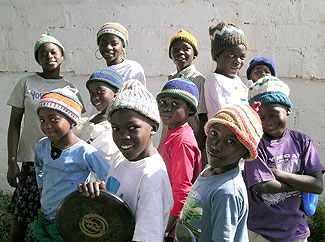
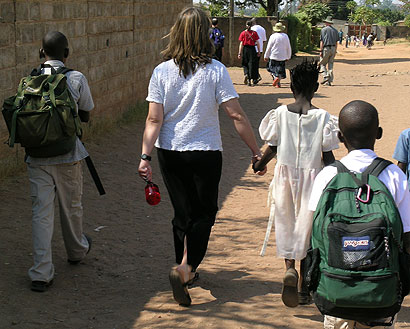
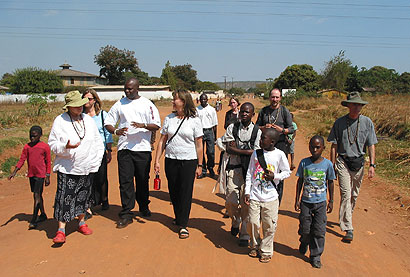

After lunch at the house, we took all the kids and picked up Brother John’s sister Theresa. We were headed to visit the area where the Kapendas grew up, Kantolomba, one of the poorest communities in Ndola. It was truly sobering to see firsthand the conditions of dire poverty there—no running water or electricity, pigs rooting through garbage heaps and open sewers. When we got out to see the home where John, Theresa and Ignatius grew up, we were mobbed by children clamoring for attention. Although the kids were dirty, barefoot and mostly wearing rags, they were truly the bright spot because their spirits seemed undaunted (our projection). Since every child in the community appeared to be a vulnerable child, we were all deeply affected by our time with them. Although many showed clear signs of malnutrition and illness, our experience with them was one of laughter, joy and fun. Brother John took the lead in playing with the kids, as when he had them all jumping up and down in an African version of “Simon Says.”
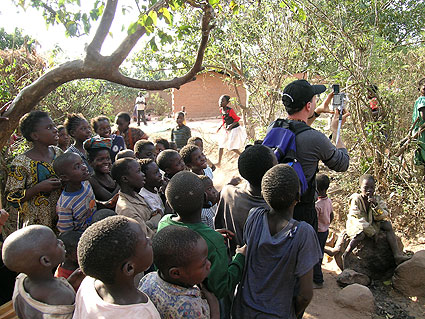
In Kantolomba
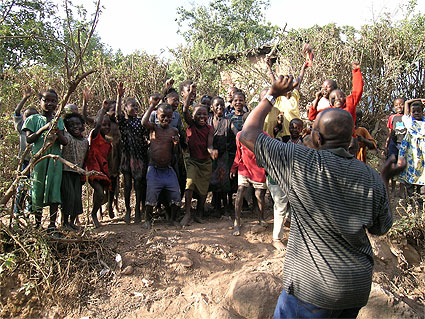
In Kantolomba
At one point we turned to Theresa and asked her if she could do one thing to make a difference in this community what would she do. She responded without hesitation that she would begin a program to provide meals for the children in the neighborhood. She commented that there are two community schools in the area that the children could attend free of charge, but many of them do not because they are hungry. Therefore a program that provides meals would allow the children to go to school. We turned to each other and agreed that it was a brilliant idea. It has been our experience again and again that the most obvious, profound ideas come from the folks who are rooted in a given community.
When we left, the children ran after us and were hanging off the back of the minibus. Back at the friary, we had an intense group discussion where we felt grateful to have this practice to process the things we had seen and experienced in this very full day.
